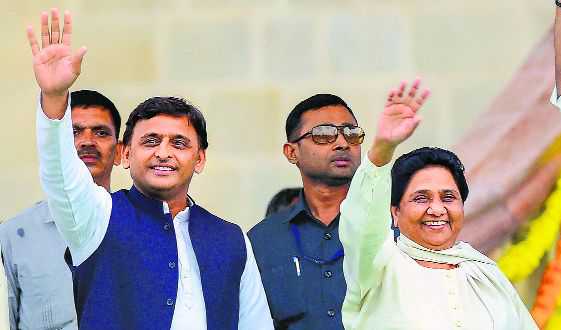
Benefit: The Congress’ strategy to contest all 80 seats in Uttar Pradesh is in the interests of the Samajwadi Party-Bahujan Samaj Party alliance.
Pritam Singh
Oxford School of Global and Area Studies, University of Oxford
Priyanka Gandhi Vadra’s entry into the electoral battle in Uttar Pradesh and the SP-BSP pact have been generally viewed for their possible significance for the 2019 General Election. Both developments certainly have that immediate significance. However, their long-term importance for UP and possibly Indian politics deserves to be explored.
It would seem counter-intuitive to propose that the Congress’ decision to contest all 80 parliamentary seats in UP would not harm the SP-BSP alliance at all, and that, in fact, it is helpful for the alliance in its strategy to win seats. The general view seems to be that the SP-BSP alliance, in keeping the Congress out, and, in retaliation, the latter contesting all seats would lead to division of the anti-BJP vote. Similarly, it would seem counter-intuitive to suggest that Priyanka’s appointment to an important position in the UP Congress is not aimed at the party winning seats in the state.
The explanation of the Congress contesting all 80 seats being helpful instead of being harmful to the SP-BSP alliance lies in the phenomenon of asymmetry of transfer of votes between the Congress and the alliance. The roots of this asymmetry lie in the caste dynamics of UP. The Congress’ multi-caste electoral base in UP has gradually shrunk and is now confined to the upper castes, mainly Brahmins. India’s first Prime Minister Jawaharlal Nehru, being a Brahmin, was a source of great pride for the community all over India, especially in UP. In India’s long history under different regimes, the Brahmin caste occupied a privileged social and religious status, but did not occupy a position of political power. Whether there were Rajput, Maratha or Sikh kings, they showed religious respect to the Brahmins, but kept them subordinate in matters of political power. India’s Independence, from the viewpoint of the Brahmin caste, opened a new era in which a Brahmin (Nehru) was elevated to the highest political office. The Nehruvian era remains in the collective memory of the community as a golden age of this caste group. In UP’s caste-based hierarchical society, this led to the building up of strong emotional ties between the Brahmins and Nehru and his party that had facilitated his rise. That emotional attachment has been carried over into the post-Nehru Congress phase. With the decline of the Congress in UP, the BJP has tried, with limited success, to make inroads into the Congress’ Brahmin vote bank.
Within the context of this caste electoral matrix, if on any parliamentary seat there is no Congress candidate, its upper caste, especially Brahmin, voters are more likely to vote for the BJP, which is the other party, especially in UP, with an upper-caste support base. Those upper-caste voters will not vote for a backward caste Yadav-led SP and Dalit-led BSP. They may not vote at all as a lesser option.
A retired civil servant with a long experience of service in North India has advanced an interpretation of NOTA, subject to further study and verification, that it represents the phenomenon of upper-caste voters spoiling their vote in SC-reserved constituencies because they cannot bear the thought of voting for an ‘untouchable’ Dalit. This caste prejudice is at the root of the asymmetry of vote transfer between the Congress and the SP-BSP. An SP-BSP voter would vote for the Congress’ upper-caste candidate if there is no alliance nominee on a seat, but a Congress voter would not vote for a lower-caste candidate of the alliance if there is no party candidate on a seat. Therefore, if there is an electoral pact between the SP-BSP and the Congress, it is clearly helpful for the latter but not for the former. Brahmins constitute roughly 8 per cent of UP’s population and electorate, though this caste group, being educationally the most advanced in the state, is much more influential due to its pivotal place in the administration and academia. The Congress putting up candidates on all 80 seats would eat into the upper-caste voter segment of the BJP and indirectly help the alliance defeat the saffron party.
On Priyanka’s entry into the political arena, this is motivated, in a more immediate sense, by the Congress sensing a mood of demoralisation among party activists due to the public impression that the party has been snubbed by the SP-BSP. Her entry, if it leads to more votes for the Congress candidates, is unlikely to secure victory except in Amethi and Rae Bareli, but it will cut more deeply into the BJP’s upper-caste voter segment and thus being even more helpful for the SP-BSP alliance.
Her presence is more likely to be beneficial for the Congress in southern states and is of long-term significance in terms of its implications for organisational restructuring of the party.
The SP-BSP tie-up is bound to lead to close coordination of their cadre during campaigning and this might have implications beyond UP and 2019 in building ties of solidarity between the lower castes. It will also have an impact on other northern states of the ‘cow belt’. If this alliance becomes stronger, it will inflict huge electoral damage on the BJP in this belt which provided 70 per cent of the total seats the BJP won in the 2014 elections. Even more important from a long-term point of view of egalitarian social and political restructuring of India is that this alliance has the potential of questioning and undermining the social and political hegemony of the upper castes.



























